This End of Year Update (2008) covers the extremely busy period September - December 2009. It is in three parts:
The Tenth Ramsar Convention Conference of the Parties/Ramsar COP
(Changwon, October 28th-November 4th)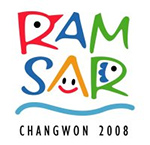
The Ramsar COP was excellently organised, and was very well-covered by domestic media. The COP provided one of the first major opportunities inside of Korea for international NGOs and overseas specialists to demonstrate their ongoing commitment to the conservation of Korean wetlands and the Yellow Sea. As such, the Ramsar COP has helped to strengthen networks and understanding, and will contribute long-term to wetland and biodiversity conservation. Immediate progress by contrast seems rather limited. On the positive side, three more Ramsar sites were proposed (all extremely small, however), and the national government reasserted its opposition to further large-scale reclamation. A formal two-page report was also provided to the Ramsar Secretariat on the impacts of the Saemangeum reclamation, with the aim of fulfilling the requirements set out in Ramsar Resolution 9.15. While allowing that major declines of shorebirds have taken place, the report still asserted that the reclamation (i.e. the destruction of wetland) is proceeding in an environmentally friendly way. No major announcements were made on any other reclamation project or internationally important wetland, and there was no hoped-for cancellation of the Grand Canal project.
The Saemangeum reclamation
This massive reclamation project continues apace. Project proponents released a new plan for the 40,100 ha site in the run-up to the Ramsar COP, with the aim of demonstrating both the technological capacity of construction companies and their commitment to wetland conservation through the conversion of natural wetland into artificial Eco-parks.
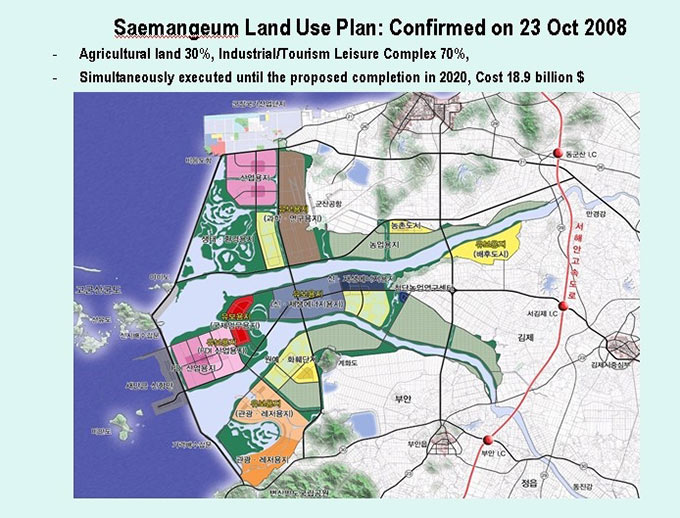 Figure 1: Saemangeum’s Future?
Figure 1: Saemangeum’s Future?Overseas companies are also starting to involve in the planning process, by invitation. These include apparently the New York-based company Urbanomics, and the prestigious Massachusetts Institute of Technology (MIT).
According to an article in the Boston Globe (September 1st) MIT’s Professor D’Hooge accepts that it is “not feasible politically” to restore tidal-flow to Saemangeum, so the MIT proposals instead include e.g. industrial facilities, parks, a Formula One race-track and even a Space Port
(http://www.boston.com/business/.../sea_change_in_south_korea/).Nowhere in the article is there any reference to whether a reclamation of this kind would be considered legal within the United States under domestic legislation, nor is there any mention of the impacts on biodiversity, nor on how the MIT proposal relates to broader Sustainable Development goals. Birds Korea aims to provide MIT and other planners with better information on the impacts of the reclamation to date, and on the urgent need for restoration of tidal-flow.
Fortunately, a far better-informed assessment of the reclamation project was provided by Reuters in late November (http://www.reuters.com/.../environmentNews/idUSTRE4AN04M20081124). This excellent article includes two (wonderfully Orwellian) quotations made by project proponents: “This project is not about protecting the environment. It is about economic development. And we will do that in an environmentally sound way” and, “Saemangeum will turn Korea into a much happier place”.
Other Reclamations
Research by both government and NGOs has already clearly confirmed the international importance of inter-tidal wetlands such as Song Do, Namyang Bay, and Aphae Island, and the national importance of the Mokpo Namhang Urban Wetland. Despite this, and the much-proclaimed policy of no more large-scale reclamation, much of the remaining tidal-flat at Song Do (Incheon) remains threatened by imminent reclamation; a new port is planned for part of Aphae Island; and part of the Mokpo wetland is being infilled. The Mokpo branch office of the Ministry of Land, Transport, Construction and Maritime Affairs reaffirmed in September its decade-old commitment to reclamation of the site, even while national officials within the same ministry work to conserve it.
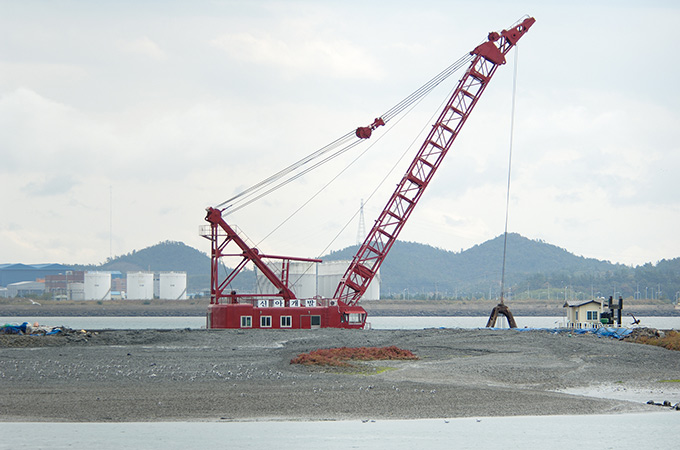 Mokpo Namhang Urban Wetland (P3), November 2008, Photo © Birds Korea
Mokpo Namhang Urban Wetland (P3), November 2008, Photo © Birds KoreaMoreover, national media in December released details of a new park-creation project proposed for the outer part of Namyang Bay (e.g. http://joongangdaily.joins.com/article/view.asp?aid=2898910).
While the inner part of Namyang Bay has already been reclaimed (with the seawall closed in 2006), the outer part remains one of the world’s most important sites for Nordmann’s Greenshank Tringa guttifer, and a still internationally important area for the fast-declining Great Knot Calidris tenuirostris. Almost 202 Billion Won has now apparently been secured to convert 970,000 Square meters of this vital area into a seaside theme park, with an extension of port facilities. Construction is planned to start in 2010. While waterbird data since 1988 clearly reveal the international importance of this wetland, there is an urgent need to register environmental concerns. Nationwide, the suggested 30-month period of environmental evaluation for major projects is now being reduced to 10 months, and red tape is to be cut away to accelerate construction projects in order to boost the economy (http://joongangdaily.joins.com/article/view.asp?aid=2898957).
 Nordmann's Greenshank Tringa guttifer at Namyang Bay, Photo © Shim Kyu-Sik
Nordmann's Greenshank Tringa guttifer at Namyang Bay, Photo © Shim Kyu-SikThe Korean Grand Canal
While the Korean Grand Canal project has also been on official hold since the summer, the new and massive economic stimulus package that was unveiled in mid-December includes a major focus on the development (or “refurbishment”) of the nation’s four major rivers. Articles in e.g. The Korea Herald of December 16th and the Joongang Daily (http://joongangdaily.joins.com/article/view.asp?aid=2898678) confirm that an extra 14 trillion won of government money will be provided to improve river water quality, to reinforce dams and banks, and to develop facilities in areas next to major rivers. Impacts on river biodiversity will likely be extremely significant.
This latest building boom will directly impact many of the nation’s remaining internationally important wetlands and much of the nation’s wetland biodiversity. It is extremely difficult to see how such fast-track development relates to the otherwise encouraging national aspiration to host both the IUCN World Conservation Congress and the World Summit on Sustainable Development (Rio+20) in 2012 (as outlined in an email posted to Ramsar COP participants by the national Minister of the Environment on December 8th).
- The period September-December 2008 has been probably the busiest in our organisation’s four-year history. Work included:
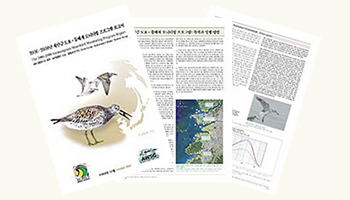
Production of the 2006-2008 SSMP Report (September-October), which summarises three years of data, and concludes that the Saemangeum reclamation is causing declines in some shorebird species at the local, national and Flyway levels. The report contains Forewords by Dr. Mike Rands (the Director and CEO of BirdLife International) and Professor Koh Chul-Hwan (of Seoul National University, and Chair of the Getobol Forum Korea). The Report was very well-received by the conservation community and media, and was only made possible by the great input of many people (and the very generous funding support of the David and Lucile Packard Foundation and other sponsors: again, so many thanks!).
Organisation of two major meetings. The first (on September 10th) was a workshop and symposium on the restoration of the Mokpo Namhang Urban Wetland, organised in collaboration with Mokpo City, as part of the Yellow Sea Large Marine Ecosystem project. The symposium was attended by c. 85 people, and included presentations by local, national and international experts (including UK Birds Korean Mr. Martin Sutherland and the RSPB’s Mr. Graham White). The second meeting was that of the Yellow Sea Partnership, held in Changwon city (November 2nd), and attended by over 30 specialists.
 Key Meetings and Participants: Symposium for the Mokpo Namhang Urban Wetland in the Natural History Museum (Left) and the Third Yellow Sea Partnership Meeting, Changwon, Photos © Birds Korea
Key Meetings and Participants: Symposium for the Mokpo Namhang Urban Wetland in the Natural History Museum (Left) and the Third Yellow Sea Partnership Meeting, Changwon, Photos © Birds KoreaPresentations given at many major meetings, e.g. the opening symposium of the Getbol Forum Korea (September 1st), an international symposium on wetland restoration at Seoul National University (September 8th), the symposium on Conservation of East Asian Coastal Wetlands in Changwon (October 27th), and the international symposium on river and urban wetland restoration, organised by Changwon City as a Ramsar conference Side-event (October 30th).
Active attendance at the Ramsar Convention conference in late October/early November (with our popular and visitor-friendly booth staffed throughout by our National Coordinator Ms. Park Meena, Ms. Lee Mi-Hi, Ms. Lee Junga, Ms. Park Hyun-Suk, Ms. Choi Min-Yeong, Ms. Cho Hyun-Shil, Ms. Tiffany Inglis & Ms. Susan Sunflower). As well supporting key meetings and resolutions (e.g. on Global Flyways), Birds Koreans distributed various materials on Saemangeum, including the SSMP reports, posters and a special CD (created by Mr. Andreas Kim, Mr. Ken Gosbell, Professor Charles Page and Ms. Tiffany Inglis). Further, Mr. Nial Moores led a session of the Children’s Ramsar on October 28th, at the invitation of the Korea Wetlands Project and Changwon City, while Mr. Rakhyun Kim especially actively involved with the various NGO networks set up for the COP.
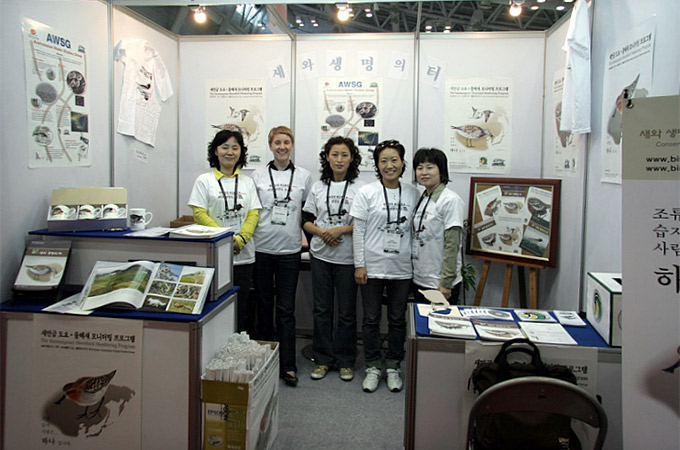 The smiling Birds Korean team at our well-visited booth at the Ramsar COP, along with our special souvenir mugs, newsletters, car stickers, CDs, SSMP reports and posters, and copies of the book "Invisible Connections".
The smiling Birds Korean team at our well-visited booth at the Ramsar COP, along with our special souvenir mugs, newsletters, car stickers, CDs, SSMP reports and posters, and copies of the book "Invisible Connections".
Photo © Birds KoreaBirds Koreans also contributed in many ways to the creation of “Invisible Connections,” which was released on October 29th. This is a wonderful trilingual (Korean, Chinese and English) book on shorebirds of the East Asian-Australasian Flyway and the Yellow Sea by Mr. Jan van de Kam (an overseas Birds Korea member) and other authors, which was produced by Wetlands International. Many Birds Koreans involved one way or another with producing this book, including translating all of the original English text into Korean (an especially challenging task wonderfully performed by Ms. Kim Sona, the Birds Korea UK Representative). In recognition of our role and the work we do, Wetlands International very generously donated a large number of copies of Invisible Connections to Birds Korea. We would like to repeat our sincere thanks to Wetlands International and Mr. Jan van de Kam for this extremely kind donation.
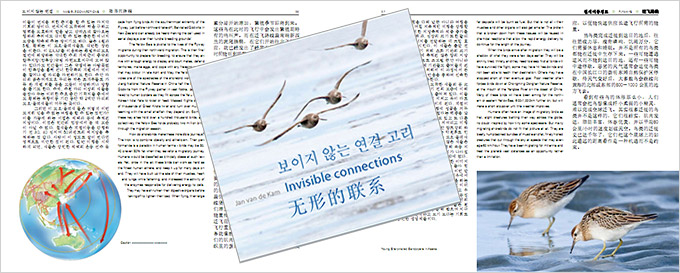
Birds Korea also provided the concept, text, and images of a 120-page long English-language environmental education textbook aimed at domestic school-students, “Healthy Wetlands, Healthy People”. Publication was funded by the Ministry of Environment and the UNDP-GEF Korea Wetlands Project and Changwon City, and copies of this book are now being distributed for use in schools in Busan and Gyeongsangnam Province.
Participation of four Birds Koreans (two from Busan, one from Mokpo and one from Shinan County) in shorebird workshops and the Monitoring Yellow Sea Migrants in Australia program (at Roebuck Bay and 80-mile Beach in Northwest Australia, between December 5th-16th). This program was organised by the Australasian Wader Studies Group and the Global Flyway Network, with generous funding provided by the government of Australia (many thanks from Birds Korea to all for such a wonderful opportunity, most especially to organisers Dr. Danny Rogers, Mr. Chris Hassel and Mr. Adrian Boyle).
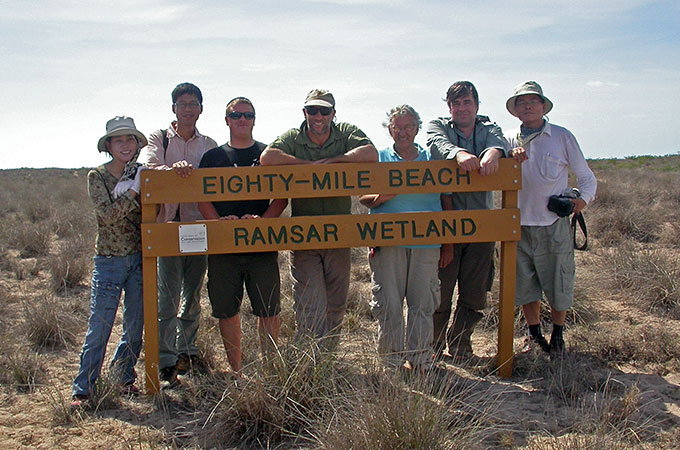 Domestic and overseas Birds Korea members together at Eighty-Mile Beach Ramsar Site, Australia, for the Monitoring Yellow Sea Migrants in Australia counting program. From left to right, Ms. Kim Hyang-Ee, Mr. Park Jong-Gil, organisers Mr. Adrian Boyle and Mr. Chris Hassel of the Global Flyway Network, Liz Rosenberg, Birds Korea Director Nial Moores and Dr. Kim Seok-Yee. Photo © Birds Korea
Domestic and overseas Birds Korea members together at Eighty-Mile Beach Ramsar Site, Australia, for the Monitoring Yellow Sea Migrants in Australia counting program. From left to right, Ms. Kim Hyang-Ee, Mr. Park Jong-Gil, organisers Mr. Adrian Boyle and Mr. Chris Hassel of the Global Flyway Network, Liz Rosenberg, Birds Korea Director Nial Moores and Dr. Kim Seok-Yee. Photo © Birds KoreaTransfer of the websites and dedicated email system to a new server (both managed expertly by Mr. Andreas Kim in Mokpo).
Media coverage during this period has been extensive and very positive, and has included full-length articles in the Kyunghang Daily, the monthly News Hankuk magazine (October), and the Weekly ChosunMagazine (October 27th), a major press conference at the Ramsar COP, based on a BirdLife International press release on October 30th, and e.g. published interviews with Reuters (on October 26th & November 24th), and the Busan Kukje Shimun (December 22nd).

Recognition of the work of Birds Korea also comes with “Mr. Nial Moores, Director of Birds Korea” being selected by the Korea Green Foundation (www.greenfoundation.org) as one of only 31 people or organisations in Korea “To Enlighten the World” in 2008. This influential list was first produced in 2005, and includes many well-known and respected people in sports, music, media, academia, and in the NGO community.The award ceremony was conducted at the Seoul Press Centre on December 29th.
Support and Donations. As an organisation with (only) 350 fee-paying members and 470 free overseas members, Birds Korea depends on grants and especially donations (of money, photographs, skill and time) to continue and to expand our work. We are therefore extremely grateful to the Queensland Wader Studies Group for a wonderfully generous donation of 11,000 AUS Dollars; for the donation of 400 UK Pounds by Ms. Regena Coult; and for the kind and personal donation of over 200,000 Korean won by Mr. Richard Grimmett.
Work highlights in January 2009 will include a survey of wintering waterbirds of west coast wetlands; completion of a report for the proposed restoration of the Mokpo Namhang Urban Wetland; and work on a short, bilingual book on Korea’s shorebirds (written by Birds Korea for the Nakdong Eco-centre, in Busan). We will also develop the second version of the Birds Korea checklist, with revised statuses and improved information on subspecies.
Annual reviews of bird records for 2007 and 2008 are in preparation. The following are a selection of only the most exceptional records for this period. Notation follows the Birds Korea Checklist (Version 1: October 2007)
Bar-headed Goose Anser indicus V3 (So)
One probable immature bird was seen well, though briefly and incompletely, in amongst a large flock of grey geese at Seosan on November 2nd by Robin Newlin. Unfortunately no images were taken and the bird could not be relocated. If confirmed, this would have been only the second record for Korea, after the first in 2003.
Siberian Crane Grus leucogeranus CR. V3
One adult at Suncheon Bay from December 1st to 4th (via Shim Kyu-Sik), and one juvenile at Goheung Bay, from December 16th until at least December 21st (when photographed by Kim Shin-Hwan). These appear to be only the 8th and 9th records, and the first since 2004.
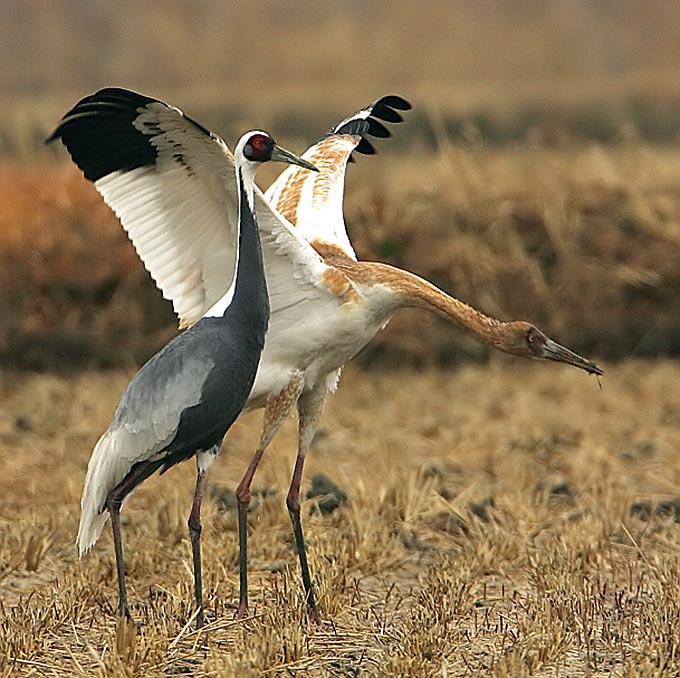
Sandhill Crane Grus canadensis V3
Three photographed together in Cheorwon, on November 30th (Via Shim Kyu-Sik) is the largest single count of this species to date, and constitutes probably only the 8th record for Korea.
Himalayan Swiftlet Aerodramus brevirostris V2 (So)
One was photographed and posted to the http://www.birddb.com website on October 3rd and again on the 6th. Location was unclear, and the names of the observers were not provided. While apparently regular in spring in extremely small numbers, autumn records remain exceptional.
Plumbeous Water Redstart Rhyacornis fuliginosa V3(So)
One male at a new site in Gyeongsangnam Province, present from at least October 3rd into November, photographed by Rob Macfie appears to be only the 9th individual record for Korea. Another male remained at the traditional site on the SE River at least until November 5th (Michael Poulsen, Martin Fichtler, Sten Asbirk, Inge Thaulow and Nial Moores).
Yellow-bellied Tit Periparus venustulus V3(So)
One first winter male, well-photographed at Namhansan on October 28th by Im Baek Ho (Birddb website), and one seen near the International airport, sometime between November 17th and 27th (Tim Appleton in lit., Nov. 2008) are only the 7th and 8th records of this species, all since the first in October 2005.
Finally, a gentle reminder to all of our members, past and present, living in Korea. Birds Korea depends entirely on the support of our members and volunteers. Donations and domestic membership fees are vital to us! Please renew your membership (annual membership fee is only 30,000 Korean won; and life-time membership only 150,000 Korean won at this time), and help us to help the birds!
This update was prepared through the joint efforts of Nial Moores, Kim Sona, Andreas Kim, Park Meena and Tim Edelsten, with contributions by many members.
Birds Korea, December 31th, 2008.



